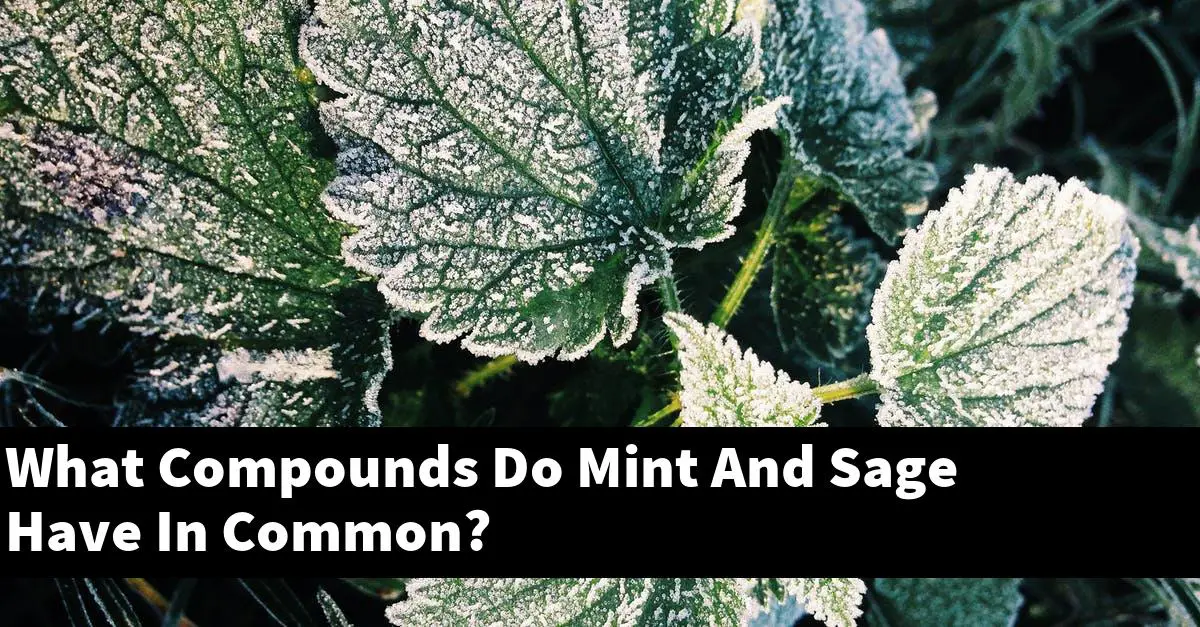Mint and sage are two herbs that have a lot in common. Both have a strong, distinct flavor that can be used to enhance a variety of dishes.
In addition to their culinary uses, both herbs have a long history of being used for medicinal purposes. Mint and sage both contain compounds that have been shown to have a variety of health benefits.
What are the chemical compounds in herbs and spices?
Herbs and spices are composed of a variety of chemical compounds, including essential oils, terpenes, and flavonoids. Some of the most common herbs and spices include basil, bay leaves, cumin, cloves, cinnamon, ginger, lemon, mint, oregano, parsley, pepper, and rosemary.
These compounds contribute unique flavors and aromas to food, and can also have health benefits. Some of the most common essential oils and terpenes in herbs and spices include basil oil, black pepper oil, cardamom oil, cedar oil, cinnamon oil, clove oil, coriander oil, fennel oil, frankincense oil, galangal oil, ginger oil, lavender oil, lemon oil, oregano oil, peppermint oil, rosemary oil, and thyme oil.
What are the properties of sage?
The properties of sage can vary depending on the sage variety, climate, and soil conditions. However, some common properties of sage include being a drought-tolerant shrub, growing quickly, and having a strong, pungent odor.
What is another name for sage plant?
Sage is another name for a member of the mint family, which includes plants like peppermint, spearmint, and wintergreen.
What is the active ingredient in sage?
Sage is an herbaceous perennial plant that typically grows to 1–2 m tall. The leaves are arranged in a basal rosette, and the flowers are small and white.
The plant is mostly composed of an aromatic oil, which is the main active ingredient. The oil is composed of terpenes, including sabinene, myrcene, and limonene.
These components are thought to be responsible for the sage’s characteristic odor and flavor.
Is sage similar to mint?
There are many similarities and differences between sage and mint. They are both herbs, but sage is more woody and mint is more herbaceous.
Both have a strong, pungent aroma and are used to flavor foods and beverages. Sage is also used as a ceremonial herb, while mint is more commonly used in cooking.
The main difference between sage and mint is the way they are used. Sage is typically used in dried form, while mint is more commonly used fresh.
Sage is also more potent than mint, and can be used in larger quantities.
How does red sage interact with other medications?
There are a few potential interactions between medications and red sage. The most common is that red sage can decrease the effectiveness of antibiotics.
Additionally, red sage can increase the risk of side effects from other medications.
How much sage is too much?
It depends on the individual’s needs and preferences. Some people may find that a moderate amount of sage helps to boost their energy and clarity of thought, while others may find that too much sage can cause them to feel drowsy or overwhelmed.
Ultimately, it is best to experiment a little and find out what works best for you.
What is the major compound in mint leaves?
Mint leaves are composed of a large number of small, thin, oval leaves that are typically arranged in a rosette. The major compound in mint leaves is menthol, which is a kind of natural cold agent.
Is sage considered a mint?
There is some debate over whether sage is considered a mint. Generally, herbs that are used in cooking or seasoning are not considered mints, as they are not typically used for their essential oil or flavor.
However, sage is specifically used for its flavor and aroma, so it may be considered a mint.
What is sage?
Sage is a flowering plant in the family Lamiaceae. It is native to the Mediterranean region, but has been cultivated and naturalized in other parts of the world.
The plant is a shrub or small tree, growing to 1–2 m tall, with a slender trunk and long, thin branches. The leaves are alternate, 3–5 cm long and 2–3 cm broad, with a serrated margin.
The flowers are small, white, and borne in spikes 2–3 cm long. The fruit is a dry capsule 2–3 cm long.
Summary
Mint and sage both contain the compound menthol. This compound is responsible for the characteristic minty smell of these plants.
In addition to menthol, both mint and sage also contain compounds that give them their characteristic tastes. These compounds include terpenes, phenols, and essential oils.

